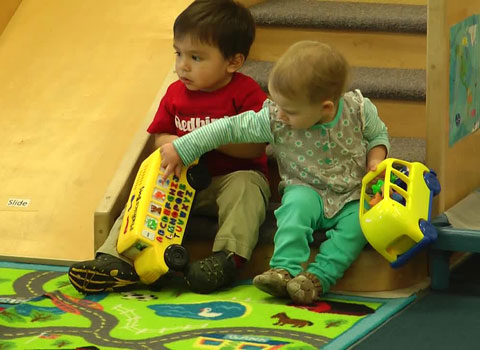About this Video
This video takes place in an infant/toddler room of a university laboratory child care center and preschool during free play time. Spencer (20 months) and Alicia (19 months) each have a toy school bus and are sitting on the steps to the loft. The off-camera teacher is interacting with them while cleaning up from breakfast and helping other children wash their hands.
Spencer and Alicia are near the steps to the loft. Spencer sits down on the first step and begins looking at the bus on his lap. Alicia sits down next to him, and Spencer puts his bus on the floor, stands up, and begins to walk away. He realizes that Alicia sat next to him, so he sits back down and smiles at her and notices her similar bus. He then picks up his bus and holds it so Alicia can look at it. This clip demonstrates a young toddler’s ability to connect a picture on a toy with a word and a sign she had been taught.
Video
Transcript
Offscreen conversations between teachers and other children for about 30 seconds.
Alicia: Duck. Duck. Duck.
She uses the ASL sign for duck.
Spencer: Ah-di-da.
Teacher: (offscreen) What?
Spencer: Up.
Teacher: (offscreen) Does it make noise?
Spencer: Up.
Teacher: I don’t know if it does. I don’t know if it has any batteries.
Alicia studies the side of the bus with the letters and pictures of animals and finds the duck, pointing to it and saying “duck.” Spencer then finds the duck and points to it.
Illinois Early Learning Guidelines for Children Birth to Age Three and strategies that caregivers used
Developmental Domain 1: Social & Emotional Development
Relationship with Peers
Children demonstrate the desire and develop the ability to engage and interact with other children.
- Strategies for interaction (16-24 months): Provide more than one of the same toy for the child and his or her peers to play with
- Action: Both Alicia and Spencer had a bus, even though Alicia was more interested in Spencer’s than her own.
Developmental Domain 3: Language Development, Communication, & Literacy
Receptive Communication
Children demonstrate the ability to comprehend both verbal and nonverbal communication.
- Strategies for interaction (16-24 months): Continue labeling the child’s environment for him or her; name or use sign language when introducing new objects or people
- Action: Although it wasn’t demonstrated in this clip, at some point an adult had introduced the sign for “duck” to Alicia. She was appropriately using the sign when looking and pointing at the duck on the bus.
Approaches to Learning
Problem Solving
Children attempt a variety of strategies to accomplish tasks, overcome obstacles, and find solutions to tasks, questions, and challenges.
- Strategies for interaction (16-24 months): Respond to the child’s communication efforts
- Action: Although not seen in the clip, the teacher is nearby and is talking with Spencer and Alicia. She responds to Alicia saying “duck” by asking whether the toy bus makes noise and talking about the bus.


